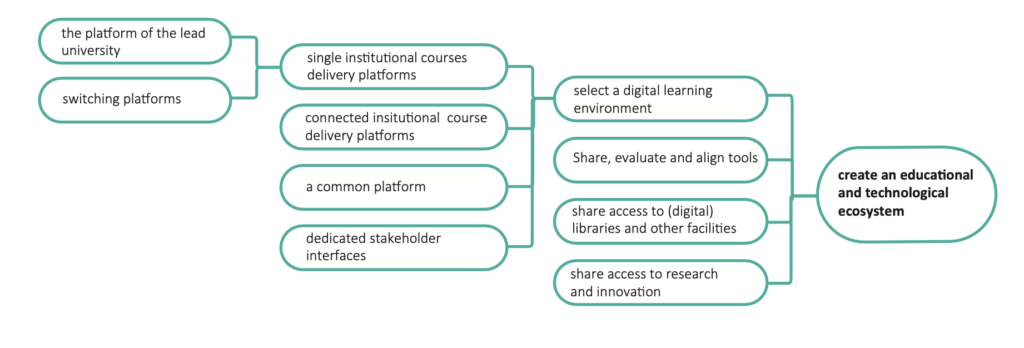
| The partnership has to take decisions on sharing a joint educational and technological ecosystem for the micro-credential programme: |
| Select a digital learning environment; |
| Share, evaluate and align tools |
| Share access to digital libraries and other facilities |
| Share access to research and innovation |
Guidelines
Select a digital learning environment
Determine on which learning environment/platform partners organize their learning activities.
A first option is for all partners to organize online learning activities on one learning platform, preferably the platform of the leading university, which is comfortable for the learners as they do not have to switch during the programme.
A second option is for students to switch learning platforms when they start a course at another partner university, which is probably comfortable for the teaching staff but less so for students. In this case, the platform is linked to the course taken. This actually reflects mobility pathways in physical joint programmes, students switching universities as the curriculum progresses. Teachers can easily use software and extensions that are linked to the learning platform they are used to.
A third option is that institutional learning platforms are interconnected. In European University Alliances (EUI), many joint programmes are planned to be delivered in a blended or online format. In this case, it is useful to look for a smart connection between institutional platforms in the alliance, serving all collaborative courses and programmes and mobility schemes. OpenU prepares middleware to make such connections.
A fourth option would be for online courses and programmes to be supported on a national or European platform accessible to all learners. Current platforms or not yet established for this purpose. In practice, the European MOOC platforms already fulfill this task for online microcredental courses and programmes courses (MOOCS) and (MOOC-based) programmes, in particular Futurelearn; France Université Numérique, FUN; Miriadax; EduOpen (EADTU, 2021).
Share, evaluate and align tools
See above, under “design the joint curriculum–Share, evaluate and align tools.
Share access to digital libraries and other facilities
Share access and guide students through the use of resources in digital libraries in the respective partner universities and faculties, extending their learning environment to other university environments for doing research, assignments or project work.
Provide students with access to institutional facilities such as digital labs, simulations, learning games, etc.
Share access to research and innovation
At universities, research, innovation and education are intertwined (the knowledge triangle). Where possible, ensure that students have access to research and innovation in the partners’ departments, e.g. to webinars, projects, thesis work, possibly as an extracurricular activity, to open minds to innovation and stimulate motivation for further international networking and study.
next chapter: Install a language policy
previous chapter: Agree on a qualification
back to overview: Models and guidelines for the design and development
of a joint micro-credential programme in higher education
